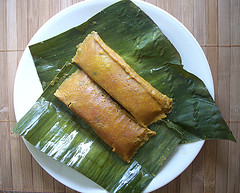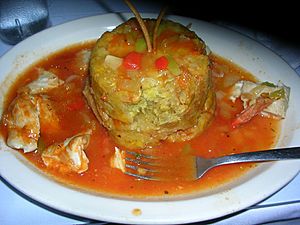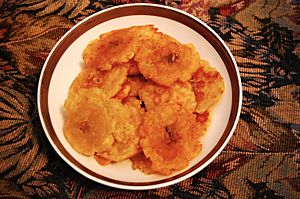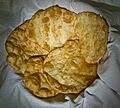Dominican Republic cuisine facts for kids
Dominican cuisine is a delicious mix of flavors from different cultures! It combines tastes from Spain, the native Taíno people, the Middle East, and Africa. Many dishes from the Middle East have become popular in the Dominican Republic, like "Quipe," which comes from the Lebanese dish called kibbeh.
Just like in Spain, lunch is the biggest and most important meal of the day. The most common lunch is nicknamed La Bandera, meaning "The Flag." It usually has white rice, red beans, and meat (like beef, chicken, pork, or fish). Sometimes, a side salad is also included.
Contents
Dishes and Their Origins
The Dominican Republic was once a Spanish colony. This means many Spanish traditions are still strong on the island, especially in its food. Many traditional Spanish dishes have found a new home here, sometimes with a special Dominican twist. African and Taíno dishes are also still very popular, and some haven't changed much at all!
Dominican food includes almost all food groups. You'll find meat or seafood, grains like rice, corn (which is native to the island), and wheat. There are also lots of vegetables like beans, potatoes, yuca, or plantains, and fresh salads. Dairy products like milk and cheese are used too, along with fruits like oranges, bananas, and mangos. People tend to eat a lot of starches and meats, and less dairy or non-starchy vegetables.
Sofrito is a mix of local herbs and spices that are sautéed (lightly fried). It's used in many Dominican dishes to add flavor. In the south-central part of the country, bulgur (a type of whole wheat) is a key ingredient in quipes and tipili. These two dishes were brought by immigrants from the Middle East. Other favorite foods include chicharrón (fried pork rinds), yautía (a root vegetable), pastelitos or empanadas (small pastries), batata (sweet potato), pasteles en hoja (ground root pockets), chimichurris (a type of burger), plátanos maduros (ripe plantains), yuca con mojo (boiled yuca with sauce), and tostones/fritos (fried plantains).
Taíno Dishes
The Taíno people were the original inhabitants of the island. Here are some of their traditional foods:
- Casabe – A flatbread made from yuca. It looks a lot like a round cracker.
- Pera Piña – A drink made from rice and pineapple peels. Before rice came to the island, it was made with corn and pineapple and called chicha.
- Guarapo de Piña – This is fermented pineapple juice.
- Guanimo – Similar to tamales, these are often served plain or filled with picadillo (ground meat).
Spanish Dishes
Many dishes from Spain became popular in the Dominican Republic:
- Arroz con leche – This is a sweet rice pudding. It's made with long-grain rice, milk, sugar, cinnamon, raisins, star anise, clove, and nutmeg.
- Buñuelos de bacalao – These are fried fritters made with cod fish. They are popular across the Caribbean and Latin America. In the Dominican Republic, they are also called bacalaíto.
- Crème caramel – A sweet egg custard known as flan. If it's made with coconut, it's called quesillo de coco.
- Gofio – A sweet cornmeal powder that comes from the Canary Islands.
African Dishes
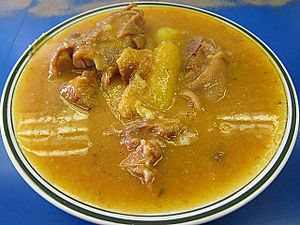
- Mangú – This dish is made from mashed, boiled plantains. Its origins can be traced back to West Africa, where it's known as fufu. Mangú is a typical and official national breakfast in the Dominican Republic, but you can also eat it for lunch or dinner. It's usually served with queso frito (fried white cheese), fried Dominican salami, fried eggs, and topped with onions cooked in vinegar. This combination is often called los tres golpes (the three hits). Sometimes, green bananas or squash are used instead of plantains, and then it's called mazamorra.
Middle Eastern Dishes
A few dishes were adopted from Lebanese immigrants who came to the Dominican Republic. These dishes have changed quite a bit from their traditional Middle Eastern versions. For example, beef is often used instead of lamb, and many spices and herbs are left out. Dominican oregano, bell peppers, and chicken bouillon are often used instead.
- Arroz con almendras y pasas – Rice with raisins and almonds. This dish is usually eaten around Christmas.
- Arroz con fideos - Rice cooked with toasted pasta. This dish is often eaten with fresh cilantro.
- Kipes or Quipes - These are deep-fried bulgur rolls filled with picadillo (ground meat).
- Niño envuelto – A cabbage roll filled with beef and rice.
Cocolo Influence
"Cocolo" is a term used in the Spanish-speaking Caribbean for people of non-Hispanic African descent. This term started in the Dominican Republic. Cocolo cuisine, brought from different parts of the Caribbean, has influenced Dominican food. Some recipes have changed, but many are still the same, just with different names.
- Chen-chen – A cracked corn pilaf dish from Haiti that became popular in the Dominican Republic.
- Dumplings - In the Dominican Republic, dumplings are eaten with braised meats or seasoned tomato sauce. They came from the British Caribbean, especially around San Pedro de Macorís. They are made from flour, water, and salt. If cornmeal is added, they are called bollitos de maíz (boiled cornmeal dumplings).
- Guavaberry - Guavaberry is used to make jams and drinks. Guavaberry liqueur, made from rum, is a common Christmas drink on many islands. In the Dominican Republic, it's linked to the eastern town of San Pedro de Macorís, which has many people of Eastern Caribbean descent.
- Yaniqueque – These Jonnycakes were brought by sugarcane workers from the Lesser Antilles over a century ago.
Cuban & Puerto Rican Influences
Dominican cuisine shares many similarities with food from Puerto Rico and Cuba. This is because people have historically moved a lot between these three islands, making their cultures closely related. It's often hard to tell where some dishes originally came from. For example, mofongo and pasteles are from Puerto Rico and became part of Dominican cuisine. Moros y Cristianos and yuca con mojo are from Cuba. The Dominican pastelón is also found in Cuba and Puerto Rico.
- Asopao - A soup with rice, chicken or fish, and vegetables, similar to Gumbo. It originated in Puerto Rico. Dominicans have their own unique asopao, sometimes adding chicharrón de pollo or coconut milk with seafood.
- Pasteles en hojas – These Puerto Rican tamales are an important part of Dominican Christmas. They are made from plantains, squash, and other root vegetables, filled with meat, and wrapped in banana leaves.
- Majarete – A corn pudding made with fresh blended corn, cornstarch, milk, vanilla, and cinnamon. Both Cuba and the Dominican Republic claim this dessert. Dominicans add nutmeg, while Cubans add lemon zest and raisins. If the corn isn't blended, it's called Chaca and sometimes includes rice.
- Mofongo – Originally from Puerto Rico, this dish is made from fried green plantains or fried yuca. It's seasoned with garlic, olive oil, and pork cracklings, then mashed with a little broth. Mofongo is usually served with a chicken broth soup.
- Sorullos - Sorullitos or sorullos are cheese and cornmeal fritters that have become popular throughout the Dominican Republic.
- Tostones – Also known as fritos verdes. These are fried green plantain slices that are flattened and salted. Tostones first appeared in Puerto Rico's first cookbook in 1859. All three islands (Dominican Republic, Cuba, Puerto Rico) claim tostones as their birthplace.
- Yuca con mojo - Boiled or fried cassava with olive oil, oregano, garlic, citrus, onions, and cilantro. This is a classic Cuban dish that is very popular among Dominicans and other Latin countries.
Dominican Dishes
These are dishes that are uniquely Dominican or have a strong Dominican identity:
- Arepitas – Fritters made from shredded yuca or cornmeal, mixed with eggs, sugar, and anise seeds. Yuca arepitas are also called arañitas ("little spiders").
- Bollitos de yuca – These are very similar to carimañola found in Colombia and Panama.
- Catibía – Empanada dough made from tapioca flour and water.
- Camarones con coco y gengibre – Shrimp cooked with coconut and ginger, using traditional Dominican seasonings.
- Chicharrón de pollo – This fried chicken dish is also known as pica pollo. The chicken is marinated in lime juice and coated with flour, garlic, and oregano. Some recipes even use rum or soy sauce for marinating. It's served with tostones and lime.
- Chulitos – Fresh grated cassava filled with ground meat and then fried.
- Chimichurris – The chimichurri is a type of burger topped with slaw. It was created by Argentinean street vendors living in Santo Domingo. It's similar to Argentinean sandwiches where meat is topped with chimichurri sauce and slaw.
- Spaghetti a la Dominicana – Spaghetti with Dominican salami, often eaten for breakfast, lunch, and dinner.
- Pico y pala – This dish uses chicken feet and neck. It's very common in local dining rooms and cafeterias, especially in lower-income neighborhoods. It's usually cooked with onions, cilantro, culantro, oregano, and sugar.
- Guisados – This refers to meat, fish, beans, or vegetables cooked in a tomato sauce base with Dominican-style "sazón" (seasoning). A small amount of sour orange or lime juice and sugar is traditionally added. Once cooked, it's served with rice. Carnes guisadas (braised meats) are a key part of the traditional Dominican lunch meal (La Bandera). Carne mechada is braised tenderloin or flank steak. Braised oxtail and cow tongue are often spicy, using scotch bonnet or other local chilies. Beans and vegetables are cooked similarly but without citrus.
- Yaroa – Layers of boiled mashed plantains or yuca, meat, melted cheese, topped with ketchup and mayonnaise. This is often sold from food trucks.
Pastelón
Pastelón can be described as a casserole or shepherd's pie. It's a very important part of Dominican cuisine. There are more than six different types in the Dominican Republic. The most popular ones are pastelón de platano maduro (yellow plantain casserole) and pastelón de yuca (cassava casserole). Pastelón can also be found in other Latin American countries like Puerto Rico, Venezuela, Panama, and Cuba. Pastelón dishes are usually filled with ground meat or chicken.
- Pastelón de arroz - A casserole made with rice, meat, and cheese.
- Pastelón de berenjena - Eggplants are sliced, floured, and fried. They are layered with cheese (often cheddar and mozzarella) and sometimes meat. It's similar to eggplant parmigiana and moussaka but without sauce.
- Pastelón de maíz - This is like a Tamale pie.
- Pastelón de plátano maduro - A sweet plantain casserole.
- Pastelón de papa - A type of shepherd's pie using Dominican spices.
Sauces
- Agrio de naranja - Sour orange juice infused with oregano, garlic, and chilies. It's a concentrated pique sauce often served with soup.
- Wasakaka – Very similar to mojo and chimichurri. This sauce is made by simmering water with garlic, parsley, olive oil, and sour orange. Once cooled, it's served with roasted chicken and boiled cassava.
Breads
- Telera – A Dominican bread similar to Mexican Telera. It's typically served around Christmas.
- Pan de agua
- Pan de coco – Coconut bread is found in many Central American and Caribbean cuisines. Its origins are thought to be between Jamaica and Honduras.
- Pan de mantequilla
Soups
Dominicans are very proud of their soups, and many cooks on the island believe they make the best ones! Soups in the Dominican Republic are often easy to make, affordable, and can feed many people.
- Aguají – A plantain puree soup seasoned with sofrito.
- Buche e perico – A corn chowder.
- Chambre or Chapea – A hearty soup with kidney beans or white beans, rice, pigeon peas, squash, longaniza (sausage), plantains, vegetables, tubers, and sofrito.
- Guandules de coco - Pigeon peas stewed in coconut milk, squash, and sofrito.
- Sancocho de guandules - Pigeon peas stewed with squash, sofrito, and pork.
- Sancocho de siete carnes – This "seven meat stew" is the national soup of the Dominican Republic. If beans are added, it's known as sancocho de habichuela.
- Sopa de mondongo - A beef tripe soup.
Rice
Most dishes in the Dominican Republic are served with long-grain rice. It's a very popular and important part of Dominican meals.
- Arroz blanco - White rice. This basic rice can be served with stewed beans, braised meat, or soups.
- Arroz con maíz or Moro de maíz - Rice with corn. This dish combines the sweet flavor of corn with the salty taste of rice, cooked with red onions, oregano, and cilantro.
- Chofan - Although it's called "Dominican fried rice," it hasn't changed much from its Asian origins, except for adding Dominican oregano.
- Concón - This isn't usually cooked on its own. Instead, it's the crispy, slightly burnt layer of rice left at the bottom of the caldero (iron pot) after cooking.
- Locrio - A classic way of mixing rice with different kinds of meat.
- Moro de guandules con coco - A dish with rice, pigeon peas (guandules), sofrito, and coconut milk, often served for Christmas.
- Moro de habichuela - Rice cooked with beans and sofrito all in the same pot.
Desserts
- Almibar de frutas – Fruit cooked in syrup. The most popular is called mala rabia, made with guava, sweet plantains, and sweet potato with cinnamon.
- Arepa – A cornmeal and coconut cake. The Dominican arepa is different from the arepas found in Venezuela and Colombia.
- Bizcocho Dominicano – Dominican cake uses a basic recipe with vanilla, eggs, flour, sugar, margarine, baking soda, milk with orange juice, and lime zest. Once baked, the cake is filled with pineapple jam and frosted with meringue.
- Brazo gitano – A rolled sponge cake with guava filling.
- Canquiña
- Dulce de coco tierno – Fresh coconut cooked slowly with milk, sugar, and cinnamon.
- Dulce de Leche en Tabla – A milk fudge usually eaten with pineapple jam.
- Habichuelas con dulce – A sweet creamed beans dessert. It's made with coconut milk, sweet potato chunks, and other ingredients.
- Jalea de batata – Sweet potato pudding slowly cooked with spices, sugar, milk, and coconut milk.
- Macaroon – Coconut macaroons are popular all over the island. Jalao are coconut macaroons made with honey and ginger.
- Palitos de coco – Shredded coconut lollipops cooked with condensed milk. They are formed into small balls and coated in a simple syrup with red food coloring.
- Tres leches cake
- Arroz con leche
- Flan
Beverages
The most popular drinks in the Dominican Republic include rum (known as romo), beer (especially Presidente), coffee, eggnog with rum, and local fruit smoothies (called batidas). Mabí is a juice made from colubrina bark or fruit, found throughout the Caribbean. Alcoholic drinks like piña colada, coquito, Cuba libre, and mojitos are also popular, some originating from Cuba and Puerto Rico.
- Batidas – The Dominican version of smoothies, often made with tropical fruits like papaya and sapodilla.
- Chocolate de maní – Peanut milk, a drink that started in South America. Modern recipes add spices, sugar, corn, milk, and rum.
- Mama Juana – An alcoholic drink made by soaking rum, red wine, and honey in a bottle with tree bark and herbs.
- Jugo de avena – A spiced oatmeal drink popular throughout South America and the Caribbean.
- Morir Soñando – A drink made with evaporated milk, sugar, orange juice, and sometimes vanilla and lime juice.
Geographical Differences
What Dominicans eat often depends on where they live: near the sea or in the mountains. In both areas, most Dominican meat dishes often include pork, as pigs are raised a lot on the island. Meat dishes in Dominican restaurants are usually very well cooked or stewed.
Dominican fishing villages by the sea have many kinds of seafood. The most common are shrimp, marlin, mahi-mahi (or dorado), and lobster. Most villagers usually eat more affordable fish, often stewed with la criolla and rice. More expensive seafood is usually for the island's upper class and tourists.
Dominican cuisine is different from other parts of the West Indies because it uses milder spices. The main spices are onions, garlic, cilantro, cilantro ancho (culantro), ají cubanela (cubanelle pepper), and oregano. Dominican sofrito is known on the island as sazón.
Images for kids
See also
 In Spanish: Gastronomía de la República Dominicana para niños
In Spanish: Gastronomía de la República Dominicana para niños




